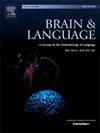Neural correlates of processing case in adults and children
IF 2.3
2区 心理学
Q1 AUDIOLOGY & SPEECH-LANGUAGE PATHOLOGY
引用次数: 0
Abstract
Sentence-initial arguments with role-specific case markers (e.g., accusatives) have been reported to be processed slower than arguments with default case markers (e.g., nominatives), both in adults and children. However, the evidence for this comes from studies that conflate word order and case, comparing initial arguments with default case and fronted (scrambled) arguments with role-specific case. Here, we disentangle these effects by studying the parsing of Basque sentences, where both role-specific (ergative) and default (absolutive) case can occur sentence-initially in canonical word order. Two EEG experiments explore how adults and six-year-old children process ergative and absolutive markers in sentence-initial position. We find that the ergative case elicits a power synchronization in theta compared to the absolutive case in both adults and children, an effect we attribute to retrieving more specific relational information from memory. In contrast, processing ergative case markers leads to a beta power desynchronization in adults but a synchronization in children. This suggests that six-year-old children are still developing top-down processing mechanisms for the parsing and integration of case marking information.
成人和儿童加工病例的神经关联
据报道,在成人和儿童中,带有角色特定格标记(例如,宾格)的句子起始论点比带有默认格标记(例如,主格)的论点处理得慢。然而,这一点的证据来自于将词序和大小写混为一谈的研究,将初始参数与默认大小写进行比较,将前置参数与角色特定大小写进行比较。在这里,我们通过研究巴斯克语句子的解析来理清这些影响,其中角色特定的(否定的)和默认的(绝对的)情况都可以在句子最初以规范的词序出现。两项脑电实验探讨了成人和六岁儿童在句子起始位置对否定和绝对标记的处理。我们发现,与绝对情况相比,否定情况在成人和儿童中都引起了θ波的能量同步,我们将这种效应归因于从记忆中检索到更具体的关系信息。相反,处理负面案例标记导致成人的权力不同步,而儿童的权力同步。这表明6岁儿童仍在发展自上而下的分析和整合case标记信息的处理机制。
本文章由计算机程序翻译,如有差异,请以英文原文为准。
求助全文
约1分钟内获得全文
求助全文
来源期刊

Brain and Language
医学-神经科学
CiteScore
4.50
自引率
8.00%
发文量
82
审稿时长
20.5 weeks
期刊介绍:
An interdisciplinary journal, Brain and Language publishes articles that elucidate the complex relationships among language, brain, and behavior. The journal covers the large variety of modern techniques in cognitive neuroscience, including functional and structural brain imaging, electrophysiology, cellular and molecular neurobiology, genetics, lesion-based approaches, and computational modeling. All articles must relate to human language and be relevant to the understanding of its neurobiological and neurocognitive bases. Published articles in the journal are expected to have significant theoretical novelty and/or practical implications, and use perspectives and methods from psychology, linguistics, and neuroscience along with brain data and brain measures.
 求助内容:
求助内容: 应助结果提醒方式:
应助结果提醒方式:


